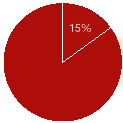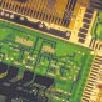|
H
E X C E L M A R K E T S Hexcel is the world’s leading producer of fiberglass electronic materials. Beyond wholly owned operations in the US and France, Hexcel’s global reach is enhanced by joint ventures in Europe and the Pacific Rim. |

Laptop computers are among the many electronic devices using multilayer laminates to increase circuit density.
|
Total 1998 Pro Forma Hexcel Sales: $1,235 million Total 1998 Pro Forma Electronics Sales: $179 million, or 15% |
|
CHIP SCALE PACKAGING: Faster, more powerful leading-edge microprocessors require special packaging to interconnect with printed circuit boards. Specially developed micro-thin fiberglass fabrics provide a platform for the new packaging technologies. |
HEXCEL HAS OPERATED in the structural fabrics industry since 1967, when the company acquired Coast Manufacturing and Supply. Hexcel’s position in this industry was strengthened in the 1980s, when it acquired Stevens-Genin, one of Europe’s leading weavers and prepreggers of fiberglass fabrics.
Since the 1980s, Hexcel light weight fiberglass fabrics have been marketed to the European electronics and telecommunications industries to strengthen the laminates used in printed circuit boards (PCBs). And in 1998, Hexcel built further on its existing growth platform in electronic fabrics with the acquisition of the Clark-Schwebel electronic fabrics business.
Printed circuit boards are used in literally thousands of electronics and telecommunications applications –including personal and mainframe computers, printers, cellular telephones, automotive electronics, advanced cable television equipment, personal communications devices, network servers and many others.
Fiberglass electronic materials are ideal for use in electronics and telecommunications applications, for several reasons, apart from their low cost: Strength, dimensional stability, temperature resistance, electrical properties, thermal conductivity and resistance to moisture and chemicals.
E x i s t i n g G r o w t h P l a t f o r m
With the acquisition of Clark-Schwebel, Hexcel was able to build on its existing growth platform in electronic fabrics in Europe. As a result of the acquisition, Hexcel established a global leadership position in fiberglass electronic materials. Prior to the acquisition, these materials accounted for about 65 percent of Clark-Schwebel’s US sales.
Today, Hexcel is the world’s leading producer of fiberglass electronic materials. Beyond wholly owned operations in the US and in France, the company’s global reach is enhanced by joint ventures in Europe and the Pacific Rim, as well as the US. Including these three joint ventures, Hexcel enjoys global market leadership, with an approximate 50 percent market share in the US and significant market shares in Europe and the Pacific Rim. The company’s strong global leadership position stems from its comprehensive product offering and its broad range of product technology.
Market conditions softened during 1998 in the electronics and telecommunications industries due to inventory adjustments throughout the electronics supply base. Demand has now improved in these markets, but pricing is under pressure as Asian and Eastern European producers with excess capacity seek outlets for their products in western markets.
T r e n d T o w a r d M i n i a t u r i z a t i o n
The trend towards miniaturization has fueled demand for multilayer PCBs, which require lightweight, higher quality fiberglass fabrics. Demand for these multilayer PCBs is growing faster than the PCB market overall, and lightweight fiberglass electronic materials accounted for over half of Hexcel’s fabric sales in 1998.
Hexcel Schwebel’s goal is to be the most effective global supplier of these electronic materials by capitalizing on global marketing relationships, enhancing global purchasing power, rationalizing worldwide fabrics operations and providing superior service and technical support to our customers.
|
COMPUTERS: Large mainframe servers, personal computers and portable laptops all use fiberglass fabrics in their internal printed circuit boards. These devices use multilayer laminates to increase circuit density. |
WIRELESS COMMUNICATIONS: Telecommunications, cellular telephones, pagers, global positioning devices and systems promise huge global growth as the world begins to communicate without the traditional infrastructure wires. |
CONSUMER ELECTRONICS: Fiberglass fabrics help deliver the low cost and top performance consumers demand from their electronic products. New technology products such as HDTV and DVD players promise high growth and higher glass fabric content. |
|
MILITARY AND AVIONICS: Military and avionics electronic products cannot fail during use. Electronic printed circuit boards reinforced with fiberglass fabrics have demonstrated reliability, even in the most demanding service environments. |
AUTOMOTIVE ELECTRONICS: New automobiles use increasingly higher electronic content for engine control systems, safety, entertainment and new collision avoidance devices. |







